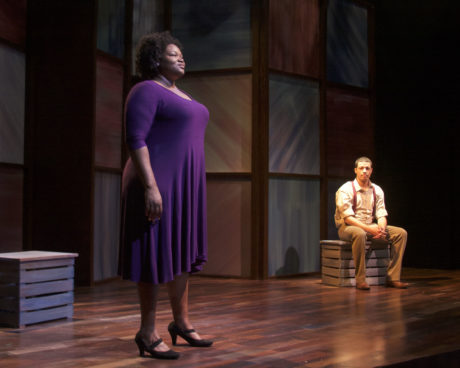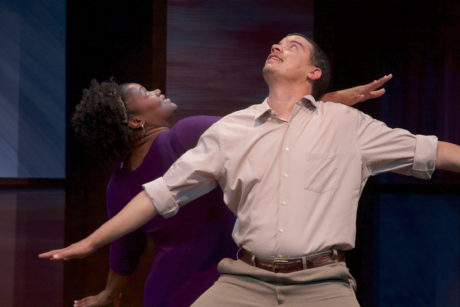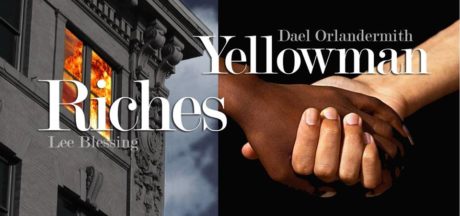I first saw Dael Orlandersmith’s Yellowman at the Manhattan Theater Club in 2002, with Orlandersmith herself in the role of the dark-skinned Alma and Howard W. Overshown as the light-skinned Eugene. The play made a profound impression on me. When I learned that Anacostia Playhouse Executive Director Adele Robey had chosen to produce it, I knew that if the acting and direction were worthy of this great play, it would be powerful. And it absolutely was—a stunning and beautiful staging of a gut-wrenching and eye-opening story.

Yellowman is a dramatization, set in South Carolina, of the lives of Alma and Eugene, friends since childhood who as they grow older fall in love. It is a complex and pain-filled narrative, composed in five sections with the two actors playing multiple roles, including people in Alma’s and Eugene’s families. (The play was a finalist for the the Pulitzer Prize in drama that year, the award going to Suzan-Lori Parks’ Topdog/Underdog, another great play written for two black actors.)
The central tension in Yellowman turns on the skin-tone prejudice that exists among and between black people in America, a form of internalized racism, sometimes called colorism, that manifests as self-hatred for being dark-skinned. This damaging dynamic didn’t come from nowhere; it’s a consequence of history; but pervasive as it is, it’s not something white people generally know much about, because that history didn’t and doesn’t happen to them. This privileged obliviousness, which also has a history, corresponds to the fact that men generally don’t know much about women’s internalized misogyny, again because it didn’t and doesn’t happen to them.
I say all this to frame the experience of watching Yellowman, which will vary by audience member perhaps more than usual, because internalized race hate and internalized woman hate are the pool of pain at the bottom of the well from which Dael Orlandersmith has drawn the character of Alma. Since the time she was a child, Alma has been blamed and berated for being large, awkward, poor, and dark:
This is what my mother and her mother before her believed / they believed had they been born “rich and high yella,” they wouldn’t have suffered….My mother and her mother before her believed / if only they could be light / light and rich / if they could marry a light-skinned man, they’d be loved.
You must see Stori Ayers’ performance as Alma. She is magnificent. The hurt inside Alma—which Orlandersmith’s script makes explicit—coexists in Ayers’ incandescent embodiment with a warmth, humor, and largesse of spirit that is a wonder to behold. And when in an instant she transforms into Alma’s mother, the bile and self-loathing she brings to the role is shocking.
Alma’s partner on stage is Eugene, a wonderfully sympathetic character that Orlandersmith has created as a lover and as a counterpoint to all the contempt Alma confronts. He has his own conflicts and issues to struggle with—including a family rife with alcoholism and a judgmental father who is dark-skinned and who resents Eugene for being light-skinned. Once, when Eugene was nine or ten, his father turned on him and said,
“Do you think I’m handsome Eugene?” and I said “Yeah, Daddy.” Then he stood over me / towering over me in all his blackness and said with incredible menace “Do you think I’d be more handsome if I was high yella like you?” and I gasped you know and inside I’m crying / screaming and another part of me wants to hurt him, hit him…
Damaged as Eugene is, and damaged as Alma is, who he wants to be to Alma, and who Alma becomes to him, turns into a heart-ache of a love story that we do not want to end badly.
Justus Hammond’s performance as Eugene complements Ayers’ superbly. Hammond too switches in the blink of an eye to bring other characters to sudden life. And his love and longing for Alma are touching and true.
Besides the two actors there are only two crates on stage. The set designed by Harlan Penn is a wall of multicolored panels meant to be nowhere in particular. But David Lamont Wilson’s compelling sound design creates a sense of place after place. And Johnathan Alexander’s lighting design is as sensitive as it is spectacular—its subtle shifts seemed organically one with the emotional energy of each moment.

Director Thembi Duncan really got this play. She just got it, everything about it. And she cast it and shaped it with enormous empathy and purpose. In her program note she writes:
I plan to explore the thread of black self-hate that originated in colonialism, runs alongside oppression, and threatens to destroy marginalized people. I see Yellowman as a story of the many ways that the cancer of oppression can live in black American bodies.
This play and this production permit us—whoever we are—to see the pain in that story with opened eyes and hearts. As such to witness Anacostia Playhouse’s searing Yellowman is a privilege not to be missed.
Running Time: Two hours 20 minutes, including one intermission.
Yellowman plays through August 14, 2016 (in repertory with Riches), at the Anacostia Playhouse– 2020 Shannon Place SE, in Washington, DC. Tickets are for sale online.
RATING:





